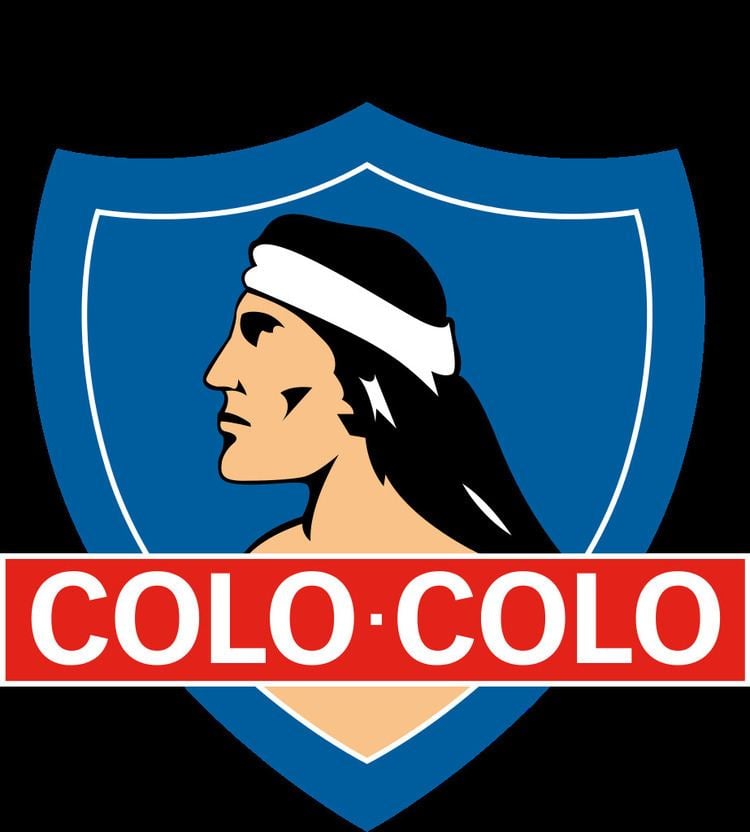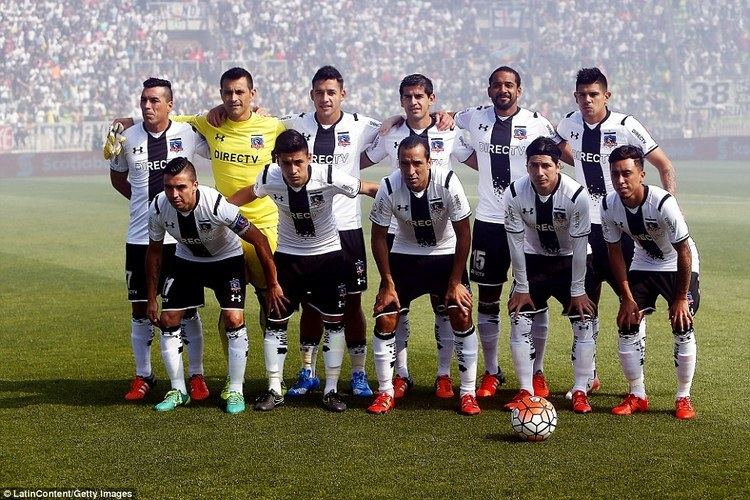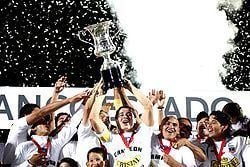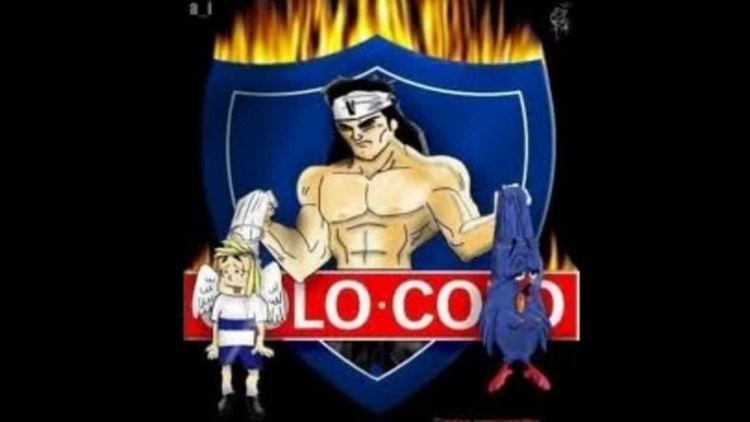Ground Capacity 47.347 | 2016 Apertura 5th Manager Pablo Guede | |
 | ||
Full name Club Social y Deportivo Colo▪Colo Nickname(s) "El Cacique""El Eterno Campeón" President Fernando Monsalve (Corporación)Aníbal Mosa (Blanco y Negro S.A.) Profiles | ||
Himno oficial de club social deportivo colo colo
Club Social y Deportivo Colo▪Colo ([colo colo]) is a Chilean football club based in Macul, Santiago. Founded in 1925, they play in the Chilean Primera División, from which they have never been relegated. The team plays its home games at Estadio Monumental David Arellano since 1989. Colo-Colo is regarded as the most successful club of Chilean football.
Contents
- Himno oficial de club social deportivo colo colo
- 19251933 Foundation and early years
- 19331973 Beginnings in professional football
- Colo Colo 1973 and 1980s dominance
- 19911999 International success
- 1999present Bankruptcy and recovery
- Badge colours and kit
- Stadium
- Players
- In
- Out
- Supporters and Rivalries
- Domestic
- Cups
- Continental
- International
- References

Colo-Colo has won more Primera División de Chile (31) than any other Chilean club and a record eleven Copa Chile titles. It was the first Chilean team to win a continental tournament conquering the 1991 Copa Libertadores after beating Club Olimpia 3–0 on 5 June with Mirko Jozić as manager. Next year, the club went on to win two international titles that were 1992 Recopa Sudamericana and 1992 Copa Interamericana, completing the club's three international honours.

The club's most winning player is Luis Mena with eleven titles, the historic top scorer is Carlos Caszely with 208 goals, and the player with most appearances is the former goalkeeper Misael Escuti with 417 games.

Colo-Colo is the team with most supporters in Chile, and holds a long standing rivalry with Club Universidad de Chile. The club also holds a traditional rivalry in matches against C.D. Cobreloa and Club Deportivo Universidad Católica. The IFFHS placed the team into the top 30 club ranking in 2007. In 2009, that same institution named the team as the 20th century's top club of its country, and also within the top twenty clubs in South American football history.

1925–1933: Foundation and early years
The team was founded in early 1925 by Magallanes' footballer David Arellano, who led a group of young players leaving the club after institutional problems. Finally, on 19 April, Arellano and the other youths officially established the club after meetings and negotiations, where Luis Contreras chose the name Colo-Colo for the club, which refers to the homonymous Mapuche cacique Colo Colo.
The team began to play friendly games, but in 1926, Colo-Colo took part in the Metropolitan League of Honour, where they were proclaimed champions and earned the nickname of "invincible". The following year, Colo-Colo became the first Chilean football team to participate in a tour across Europe. However, on 2 May, during an exhibition match against Real Unión Deportiva at Valladolid, the team founder and captain David Arellano was critically injured after suffering a collision with an opposing player that caused him Peritonitis. The inflammation would lead to his death the next day. Despite the great impact caused by the death of Arellano, the club won the tournament of the Central League of football – then renamed Asociación de Football de Santiago – in the 1928, 1929 and 1930 seasons.
In the 1931–32 season, Colo-Colo suffered its first institutional crisis because of financial problems, which led to a salary reduction for first team footballers and board members, with their consequent resistance. The team played another tournament final that season against Audax Italiano. However, due to a collapse of a platform at the Estadio Italiano and subsequent roughhousing by fans, the game was suspended while the "Albos" were winning 2–1. That day's tragedy resulted in 130 injuries and three deaths. The match was canceled and the champion position for that year remained vacant. Other authors however declared that both Audax Italiano and Colo-Colo were declared champions.
1933–1973: Beginnings in professional football
One year later, six Santiago based clubs along with Colo-Colo decided to create the first professional league within the country, which was established in 1933. On 23 July, the team won the Campeonato de Apertura (precursor of the Copa Chile), after defeating Unión Española 2–1. However, in the first Primera División official tournament, Colo-Colo finished first alongside Magallanes, which forced the "Cacique" to play a tie-breaker match that Colo-Colo lost 2–1. In 1937 the team was undefeated, leading to their first league title. Two seasons later, in 1939, Colo-Colo won the league title for the second time now under the guidance of the Hungarian coach Francisco Platko, with the highest scorer being Alfonso Domínguez, who scored 20 goals in 24 matches. After another title in 1941 with Platko as coach, the club went on two win honours in 1944 and 1947. The following year Colo-Colo organized the South American Club Championship – precursor of the Copa Libertadores – in Santiago, which brough together the 1947 champions of the continent. In 1945, the club had the worst season in its history, finishing penultimate in eleventh place only ahead of weak Badminton.
In the early 1950s, club's president Antonio Labán hired Newcastle United striker George Robledo for £25,000, who with his goals led the team to the tournaments of 1953 and 1956. During that decade, the club acquired a terrain at Macul, where construction of the Estadio Monumental began (inaugurated in 1975). Despite of that acquisition, the directive invested in a headquarters located at Santiago Centro – address Cienfuegos 41 – in 1953. The next decade saw Colo-Colo win honors in 1960 and 1963. The 1963 team broke two records: Luis Hernán Álvarez scored 37 goals in a single season, which was the highest number of goals scored by a footballer of Colo-Colo during a single season. The second new record was the highest number of goals scored by a club (130) in one football season. In the late 1960s, the club played several seasons where their rivals Universidad Católica and Universidad de Chile dominated. However, the team won its tenth honour in 1970.
Colo-Colo 1973 and 1980s dominance
In 1972, now under the orders of coach Luis Álamos and with figures like Carlos Caszely and Francisco Valdés, the club won another championship. It also obtained the country's attendance record of 45.929 people for a single season. That team was the basis of the so-called "Colo-Colo 73", the first Chilean team to reach a Copa Libertadores final, where it lost against Independiente of Argentina. After Colo-Colo's brilliant campaign, the club went into a competitiveness and institutional crisis not being able to win another league title until 1979. That team featured the talented Brazilian midfielder Severino Vasconcelos alongside a returning Caszely.
In the 1980s, the club obtained the league titles of 1981 and 1983 with coach Pedro García, and the 1986 and 1989 honours under Arturo Salah. The 1987 Alianza Lima air disaster claimed the lives of sixteen players and Colo-Colo was the first to help the Peruvian team, loaning them 4 players. Nonetheless the team won four Copa Chile titles in that decade. During that period, the greatest disappointment was at the continental tournament level with the team only exceeding the first stage in the 1988 Copa Libertadores. On 30 September 1989, the Estadio Monumental was inaugurated with an opening match against Peñarol, that Colo-Colo won 2–1, with goals by Marcelo Barticciotto and the striker Leonel Herrera, the son of a 1970s legendary former defender of the same name.
1991–1999: International success
The 1990s was the most successful decade in the club's history for the national and international honours achieved. Croatian Mirko Jozić arrived as coach, leading the team towards its first Bicampeonato for winning two national titles in a row. On 5 June of that year, after beating Olimpia 3–0 at Monumental with two goals by Luis Pérez and one by Leonel Herrera, Colo-Colo became the first Chilean team to win a Copa Libertadores. That same season, the "Albos" lost the Intercontinental Cup final against Yugoslavian club Red Star Belgrade, after being defeated 3–0 in Tokyo. At the local level, the club won the 1991 league, its third-consecutive title thus achieving its first Tricampeonato. The following season, the club won the Recopa Sudamericana, after beating Brazil's Cruzeiro in a penalty shootout, and also obtained the Copa Interamericana, after winning 3–1 against Puebla in Mexico. The last title won by Jozić in Colo-Colo was the 1993 league title, thus closing a successful spell in South America.
After Jozić's departure, came a little drought in national titles, but the team managed to get an unforgettable 3-0 win over arch rivals Universidad de Chile in 1995. The team was champion of the 1994 Copa Chile and reached the 1994 Copa Libertadores quarterfinals. The following season saw the arrival of Paraguayan coach Gustavo Benítez, who obtained the 1996, 1997-C and 1998 honours. The team advanced to the semifinals of the Supercopa Libertadores in 1996, and of the Copa Libertadores in 1997, being eliminated both times by Cruzeiro. In 1999, Colo-Colo lived a similar situation to 1994, finishing fourth in the Chilean league and having three coaches during that single season: Brazilian Nelsinho Baptista, the caretaker manager Carlos Durán and then Fernando Morena of Uruguay, who remained until 2001.
1999–present: Bankruptcy and recovery
In 1999, after Benítez's departure, the club entered a serious financial crisis. In January 23 of 2002, after years of economic missmanagements under the leadership of Peter Dragicevic as president, the club was declared bankrupt. Justice named Juan Carlos Saffie as syndic responsible for the institution allowing it not to lose its legal status. Despite the bankruptcy, under Jaime Pizarro as coach – key player in the obtaining of the 1991 Copa Libertadores – Los Albos won the Torneo de Clausura, with an almost completely juvenile squad. Three years later, in 2005, the joint-stock company Blanco y Negro took over the administration, concessioning all club assets for thirty years in exchange for paying all debts through an opening process at the Santiago Stock Exchange. In the first half of 2006, the judiciary court sentenced the end of bankruptcy.
With the Argentine Claudio Borghi as coach since 2006, and with players like Matías Fernández and Humberto Suazo, Colo-Colo obtained a Bicampeonato winning the Apertura and Clausura tournaments. The squad reach another international final, the Copa Sudamericana, losing 2–1 to Mexico's side Pachuca. That season, El Cacique was recognized by the IFFHS as the world's club of the month. The following season Colo-Colo won two more consecutive tournament, winning a Tetracampeonato for winning four back-to-back championships, being the first Chilean team to achieve that.
After Borghi's departure, the club obtained its 28th title after defeating Palestino in the 2008 Torneo de Clausura finals under the coaching of Marcelo Barticciotto, and with Lucas Barrios as principal scorer, who equaled Luis Hernán Álvarez record of highest number of goals scored by a Colo-Colo footballer during a single season with 37 goals. The following season, the club became the first professional team to play in Easter Island. After a poor Torneo de Apertura 2009 – not reaching the play-offs for the first time – Los Albos started the Clausura very close to relegation positions. However, the team reached the tournament's finals against Universidad Católica, beating them 4–2 in Santa Laura, with players like Esteban Paredes, Macnelly Torres and Ezequiel Miralles, coached by Hugo Tocalli. Colo Colo's last championship was in 2014 after winning the Torneo de Clausura. It was the team's 30th Chilean League title.
Badge, colours and kit
The club's badge represents Mapuche chieftain Colo Colo, an important Wall Mapu member who battled in the Arauco War against the Spanish empire (1536–1818). On 19 April 1925, when the club was established, Luis Contreras – one of the players that founded the club – defined the team's badge, in representation of the chief and the country's indigenous people.
Throughout its history, Colo-Colo’s uniform has been a white shirt and black shorts. The uniform was originally designed by Juan Quiñones following the recommendations of David Arellano. In 1927, during the club’s tour in Europe, Arellano died while playing against Real Unión Deportiva (currently Real Valladolid). It was decided then that the badge will wear a black horizontal band over it forever, to represent the institution's eternal mourning. For that reason, the club was nicknamed The Mourners during the 1930s.
The team’s away kits have varied along its history, from green between 1927 and the mid-1970s and to red from 1975 to 1988. Nowadays the away kit is an all black uniform.
Stadium
Colo-Colo initially played on a field called Estadio El Llano but in January 1928 moved to the Campos de Sports de Ñuñoa. The team later moved to Estadio Nacional where the club played from 1939 to the late 1980s. In 1946 the club bought a stadium from Carabineros de Chile – then called Fortín Mapocho – that was closed because of security reasons. It was intended to build a 30,000 seat stadium at the site. However, a municipal ordinance prohibited construction in the area. For that reason, Colo-Colo sold the stadium in order to raise funds for the future Estadio Monumental.
In 1956, club's president Antonio Labán acquired a 28ha terrain at Macul, close the intersection between Vicuña Mackenna and Departamental. The new stadium was originally planned with a capacity of 120,000. Due to the work's high cost and lack of a government subsidy the project was halted. In 1960, after Chile's successful proposition to hold the World Cup, several congressmen proposed to build a 52,000-seat stadium in Colo-Colo's site. However, the 9.5 Valdivia earthquake and a willingness from congress to veto any public funding to non-governmental entities stopped the initiative.
Colo-Colo's brilliant campaigns of 1972 and 1973 allowed the stadium construction to resume. It was inaugurated in 1975 in a 1–0 league win over Deportes Aviación with Juan Carlos Orellana becoming the first player to score a goal in Monumental's history. However, the stadium was closed due to lack of basic services and infrastructure. It was not reopened until 1989 thanks to Hugo Rubio's transfer to Bologna which allowed the club to receive US$1 million. The stadium was called Monumental David Arellano in honour of its founder and its definitive inauguration was in a match against Uruguay's Peñarol which Colo-Colo won 2–1. Marcelo Barticciotto scored the first goal.
Since its definitive opening, the stadium has seen the 1991 Copa Libertadores and 1992 Copa Interamericana obtentions as well as several league titles. Monumental's public record attendance was in 1992 during a derby match with Universidad de Chile which registered an attendance of approximately 70,000 fans. That record was closely followed in August 1993 during a 2–0 exhibition match win over Real Madrid with a 67,543 attendance. Several remodeling works and stricter security brought down the total capacity to 47,347.
It's worth noting that the Chilean national team has used the stadiums in some of its games since 1997, both in friendlies and in games leading to the qualification to the 1998, 2010 and 2014 World Cups. The stadium was also used during the 2015 Copa América.
Players
Note: Flags indicate national team as defined under FIFA eligibility rules. Players may hold more than one non-FIFA nationality.
In
Note: Flags indicate national team as defined under FIFA eligibility rules. Players may hold more than one non-FIFA nationality.
Out
Note: Flags indicate national team as defined under FIFA eligibility rules. Players may hold more than one non-FIFA nationality.
Supporters and Rivalries
Colo-Colo is the club with the largest following in Chile, with approximately 42% of the total Chilean football fans according to research published in August 2012 by Spanish newspaper agency Marca,. The study showed a 4% growth in comparison to a 2006 research by Fundación Futuro that ranked the club in first place with the 38% of the preferences, leaving its rival Universidad de Chile in second place.
Since the early 1960s, the club has organized fan groups, which evolved in the mid-1980s into the so-called Garra Blanca. They attended Colo-Colo's games and generally rioted, especially in derbies, turning Estadio Monumental surroundings into battlefields against the military police. In 2000, the group was declared as Barra brava.
